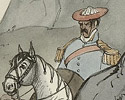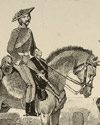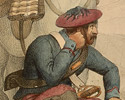19th Century´s militar history in the Basque Country
The carlist cavalry
 Zumalacárregui set about creating a small cavalry corps, which he trained in the use of the lance up until September 1834, when he used it in Viana.
Zumalacárregui set about creating a small cavalry corps, which he trained in the use of the lance up until September 1834, when he used it in Viana.
The Liberal Carondelet had 300 Royal Guard horsemen when he was attacked by 200 Lanceros de Navarra (the Lancers of Navarre) with the Carlist leader at their command. After two fierce attacks, the Carlists sent off an elite group of the Liberal cavalry to seek refuge in the neighbouring city of Logroño.
One of the most skilful leaders of the Carlist cavalry was Carlos O'Donell. Henningsen wrote that, until the latter's arrival, the Lanceros de Navarra were "almost as undisciplined and ignorant of all military evolutions as a horde of Bedouins". At O'Donell's death in May 1835, the regiment was disciplined, fully equipped, and capable of matching the manoeuvres of the very best of the Queen's army.
 The role of the Carlist cavalry in the Basque Country was never very significant. Neither the geography nor the tradition of the region helped it very much. However, diverse squadrons and regiments were organised in addition to the Lanceros de Navarra. Alava had its Húsares de Arlabán and a Guipuzcoa Squadron was also set up. There were many Castilian squadrons, particularly during the Expeditions phase; these included the Príncipe, which escorted Maroto when he was general-in-chief, the Princesa, an old Cantabrian squadron and the Húsares de Ontoria, formed by Balmaseda.
The role of the Carlist cavalry in the Basque Country was never very significant. Neither the geography nor the tradition of the region helped it very much. However, diverse squadrons and regiments were organised in addition to the Lanceros de Navarra. Alava had its Húsares de Arlabán and a Guipuzcoa Squadron was also set up. There were many Castilian squadrons, particularly during the Expeditions phase; these included the Príncipe, which escorted Maroto when he was general-in-chief, the Princesa, an old Cantabrian squadron and the Húsares de Ontoria, formed by Balmaseda.
The harsh times experienced by the Carlist army and the problems it had obtaining horses is revealed by the fact that the cavalry corps had two "unmounted" companies, which acted as coastguards.
 The Expeditions phase was the Carlist cavalry's greatest moment. The corps was essential here for efficient manoeuvring on the plains of the meseta. In May 1837, some 1,200 horsemen left with the Pretender on the Royal Expedition. The failure of this expedition, thought it did not suffer any major defeats, marked the end of this type of project and hence the significance of this military.
The Expeditions phase was the Carlist cavalry's greatest moment. The corps was essential here for efficient manoeuvring on the plains of the meseta. In May 1837, some 1,200 horsemen left with the Pretender on the Royal Expedition. The failure of this expedition, thought it did not suffer any major defeats, marked the end of this type of project and hence the significance of this military.

